
Revolutionaries on the Bridge
Single Channel Video 2017
I found messages on Brooklyn Bridge, NYC. I just manipulated and left other messages which are issuable political comments about communism. As a matter of fact, it may be impossible to write revolutionaries' messages on the bridge where is the empire city of the iconic capitalism: it’s too much radical and off-the-wall. I might convey the banned slogan by this CG faked video like vandalism, graffiti. People wrote their ideas and thoughts on the metal frames like freedom of speech. The manipulated messages might stab in our mind unconsciously and make us think the meaning of truth and revolutions.
Sorry about your wall
Single Channel Video 2017
Banksy is a criminal, But I am not.
Single Channel Video 2012

Banksy’s art work is fantastic and inspiring. I can honestly say he is one of my favorite artists. However, one must face an uncomfortable truth: his artwork is a form of vandalism. Therefore, in a way, Banksy has committed many misdemeanors and is somewhat of a criminal! Worse, he commits his crimes habitually. Graffiti is illegal in South Korea if we do so without permission, but there are some areas in South Korea in which it is permitted. I committed acts of vandalism as art in the core of the country: Seoul, the capital of South Korea.
I conducted an art form of vandalism (a.k.a., Graffiti) in the core of city, Seoul, South Korea.
I stenciled graffiti on the walls that were either symbolic or subversive. I drew graffiti in various places: from the U.S. Army base to the government buildings, and the buildings belonging to major companies regardless of whether or not I was in plain view. This is considered shocking behavior in Korea, especially since it was done in broad daylight. The video was meant to have a similar impact on people as Banksy’s work. However, I didn’t actually vandalize the city. In fact, it was a complete fraud. The video was manipulated.
I regard this series to be connected to the religious theory of Manicha from the Tibetan religion. People believe that if they put their prayer in Manicha and spin it, Manicha prays for them. How are they able to believe this, and why does it work? The answer is simple: it is part of their belief and customs.


Photoshop Series
Single Channel Video 2011 - 2012
 | 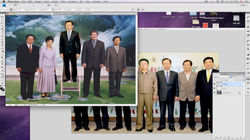 | 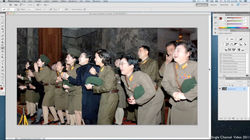 |
|---|---|---|
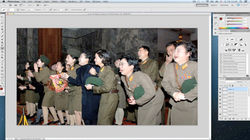 | 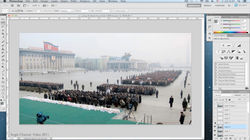 | 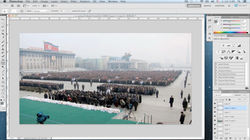 |
The technology of image editing has caused massive innovations in the media and has influenced the mass media extensively. People now believe that manipulated images are, in fact, information. Advertisement, films, and videos have affected every nation.
In totalitarian and communist regimes, it is even easier to find examples of manipulation of the media in order to create a cult of personality and influence people into believing whatever is put out by the media, when in fact the government is behind all the information. Even in capitalist countries, the media is used to control and govern people’s thoughts. Today, with social media, that manipulation occurs instantaneously.
Due to these factors, the line between truth and falsehoods is getting weaker to the point where it has almost faded away. I want to demonstrate what the media does to alter the mindset of people in a given society. Through these videos, the audience may be able to see and understand how this procedure works and how hypocritical the information that is being produced really is. I intend for audiences to believe that the images are real, or at least be confused by them.
They will probably realize that these images are false. However, in doing so, they gradually lose their ability to distinguish between the two. No matter what they feel, this is a message to the audience that they should wake up and doubt reality.
Firstly, I showed my process of manipulation. It is simple. I recorded a computer screen wherein I manipulated the images used with a Photoshop program. Some images have already been suspected as false. The images might seem real, or very unreal, causing controversy. Furthermore, I picked pictures that appeared to be unreal, because a photographer could have intentionally designed the scenes.
One picture is a solemn moment at Kim Jon-Il’s funeral, the former dictator of North Korea. People in the picture appear to be overtly grieving. I manipulated these images doubly. First, I manipulated a picture to make it a false one, and then I put it back to the original image through a similar process. The video repeatedly shows this process. Audiences do not know what to make of this, because the process doesn’t make a clear distinction between reality and falsehoods.
APART
Single Channel Video 2012
Apartments are the most common type of housing in South Korea. The shape of this building appears to be a huge concrete cube. In the city, the apartment complex includes wide space for residents. There are valid reasons why Koreans prefer to live in apartments. They ensure a more convenient lifestyle, because they are set up with infrastructure such as a large-scale water system, electricity, parking lots, as well as proximity to schools, markets, and police stations. Moreover, the city has been designed for residents to live in apartment complexes because in Seoul there is a large population in a limited area. I feel that apartments are symbols of the lifestyle of South Korea. They can be described as part of modern culture.
Apartments have gradually changed the Korean lifestyle. Unlike in the past, when agriculture was an important part of the economy, when people depended on trade, these days people are more isolated from their neighbors and communities. The individuals who live in apartments are now more independent and have an individualistic approach to life. There is very little interaction with one’s neighbors.
My intention was for the apartment to appear similar to the movie scene in Stanley Kubrick’s “The Shining.” The twin apartments create a grotesque image, similar to the identical twins in the movie.
The atmosphere appears uncomfortable; to point out that Korean life is becoming isolated.
Work Process
I arranged twin apartment buildings on a screen. One of the buildings is occupied; the other is vacant. This opposing situation appears strange. On the right side, the building looks like a normal, residential place. The audience may recognize that the inhabitants appear autonomous from others.
However, on the left side of the building, it is vacant. Only one light shines in the window. In other words, only one house has its lights turned on. This light starts to shine, and it creates a message in Morse code. In order to enhance this strange atmosphere, I set up other objects in this scene. Cars on the road also create similar messages when passing the central point.
Refer to image from Rene Magritte <Not to be reproduced>
The Hole
Video Interactive Installation 2011
When we look in a mirror, we can only see the front of our face. In other words, we cannot see the back of our head. However, if we have several mirrors, we can see from other angles in order to see other parts of our bodies.
The purpose of the hole is to demonstrate how real figures cannot be reflected in a mirror. According to Lacan, a French psychoanalyst, a symbolic mirror reflects one’s inner beauty and ugliness at the same time. This contains two contradictory meanings: narcissism and Medusa’s mirror.
“Not To Be Reproduced” was painted by Rene Magritte, and shows a grotesque image. This is the basic purpose behind the hole: I wanted to show this kind of contradictory situation with installation art. To that end, I designed an interactive device. I thought a well would perfectly demonstrate contradictory images.
When people approach a well, they expect to see their face reflected in the surface of the water. However, its depth and darkness alter what they see. In addition, viewers find themselves in mysterious surroundings while they watch their own reflection in the water surface. The vague shapes on the surface of the water appear to be a human figure. It appears in the deep, dark well water. It is a dreadful image from the past.

My installation suggests a surreal idea. Although viewers expect to see their faces in the water’s surface, they cannot in fact see themselves. They can only see the back of their heads. In the end, this causes various reactions and unusual emotions.
I achieved this by setting up a small camera under the roof. This camera shot the inside of the well in real time. When a viewer looks under the hole, they can see the back side of their head. It’s unexpected. The screen that is set up under the water shows the back of the viewer, although it spears to be a reflected image on the surface of the water.


Between Truth & Falsehood
Video Installation 2010
There are small, drilled holes on a steel plate.
The steel plate consists of one side of a box, and I installed an LCD monitor inside. The filming for documentation shows the work process of how I went about drilling holes into the steel plate. The audience is only able to watch this through the holes.
The video causes them to understand the process of drilling holes in steel. In the end, the audience begins to doubt my work process, because the punching process I had shown is nonsensical. However, it’s interesting that people believed it in the first place. The audience cannot, in fact, say whether this is true or false. It confuses them, and begins to make them curious. Eventually, they need to make a choice as to whether they believe the film or not.

Documentation
Asclepius
Single Channel Video 2010

“Crito, we owe a cock to Asclepius. Please, don't forget to pay the debt.”
—Socrates Final Words—
Asclepius is god of healing and medicine.
The Greeks of Socrates’s time donated one chicken at the temple of Asclepius when their diseases had been cured. Socrates’s last words were that pain was cured through death. Human beings are subconsciously aware of their own demise, which they associate with fear. On the other hand, Socrates’s interpretation of death was of the halcyon persuasion.
This short film shows the meaning of Socrates’s last words and his analysis of death which some people confront either through their conscious or unconscious thoughts.
Synopsis:
The hero in the short film is calmly sleeping, and his alarm clock represents an interruption. The man turns off the alarm clock when it breaks his peace, but it doesn’t stop. Moreover, it constantly plagues the man. Due to his struggle with the alarm clock, he wakes up in a different place, where he is in the ER awaiting his own impending death.
The doctor is trying to save him, and the man in bed looks to be in critical condition. When the alarm clock rings again, the scene is switched from the emergency room to the previous scene.
Finally, after much trial and tribulation, the man can’t stand hearing the irritating alarm; he breaks the alarm clock. Later, he is eventually able to sleep comfortably in his bed.
Human life is bound up by time. The alarm clock is an object that represents reality, but also people have probably experienced the urge to turn off the alarm when it disrupts a deep sleep. In the world, people live with objects they must confront, like a shrieking alarm clock. Humanity may not discover a peaceful world; but then again, perhaps this peace is not found in the real world but in fantasy.

Time Decomposition
Single Channel Video 2009
The media is often extremely hypocritical. I tried to break down the culture of hypocrisy which has been created in the media by flipping over the attributes of the media. First of all, people need to consider whether an absolute truth in the world can exist absolutely. Once an idea gains a foothold, it permeates the entire society and creates limitations. Albert Einstein posed the question, “why does the Earth orbit the sun?” This is where his theory of relativity came from. In my view, art also plays a role in bringing us closer to the truth.
Production Method
A man is walking on a bridge at sunset. The sun is in the background, and the man is walking painfully slowly. He moves like he is in slow motion. Meanwhile, a cameraman films him walking. The camera moves as slowly as the man’s pace, and the man seems to have walked until sunset. After the filming was complete, the video changes speed, making the man appear that he is walking at a normal pace. In addition, a recorded sound clip of ambient music is slowed down during the second clip, because I was able to easily modify through editing each part of the video and sound clips. In the video which is sped up, although the man is walking at a normal pace, it seems that the sun in the background is setting very quickly. The speed of sound is also slowed down. Three different speeds are shown. The video, therefore, shows three different speeds of time—normal, sped up, and slow which co-exist in one shot. Even though time is linear, my video shows time moving in quite a different fashion. The significant point I am trying to make is that if you focus on the man who is walking, all objects in the frame destroy our notions about time and the video appears to counter the laws of time.